Cogmind recently made it through a second whole year of its pre-Steam early access program, and as this period comes to an end I'd like to take the opportunity to, like the first year, share some data and pretty graphs :)
This is an interesting milestone because it more or less coincides with the completion of Cogmind's primary content, represented by the Beta release just last month, meaning it took around two years of work to bring the game from Alpha 1 to Beta 1. And it's still amazing that support has been sufficient to maintain full-time development for this long--Cogmind's lifetime revenue passed the $100k mark in April :D. So a big thanks to everyone who has helped it reach this stage!

Cogmind Beta Launch ASCII Fireworks
@'s celebrate the Beta :)For a more general summary of late-alpha progress you can check out the data in my 2016 annual review, whereas this article will instead be mostly looking at revenue and pricing. And while the first year of sales data was neat simply because it was seemingly the first time anyone in this genre has provided so much open data, the second year is much more interesting due to tier and pricing changes.
Revenue
Let's jump right in: Cogmind made US$ 40,325 in its second year. Looking purely at the numbers, that's only two-thirds of what it made the year before, but it's important to note that a $25k chunk of year 1 revenue was earned in the first month of alpha alone, the result of pent up interest from two years of open pre-alpha development prior to that. In that light, the second year has technically been a little better than the first in terms of revenue, an 8% increase from $37k to $40k.
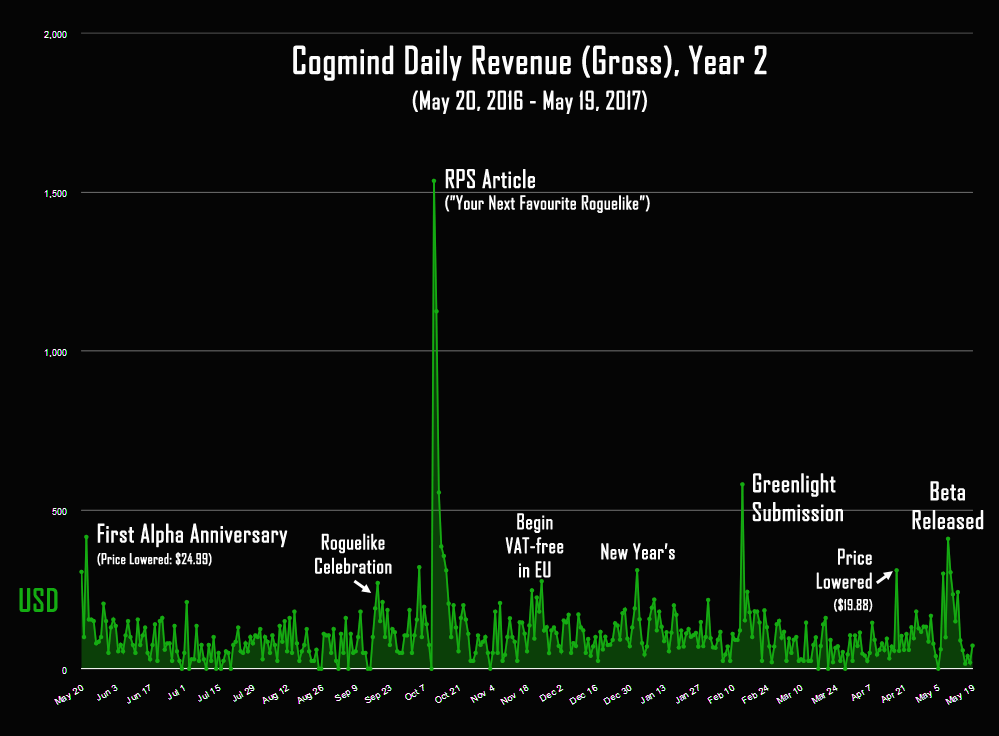
Cogmind Daily Revenue (Gross), Year 2
Cogmind Year 2 daily gross revenue, annotated (Year 1 graph here). (Click on any image in this article to see at full size.)Year 2 started with a minimum price drop, from $30 to $24.99 (albeit by adding a new lower tier without any perks, and keeping the old price as an option). This naturally sparked a good number of sales in the short term, which eventually died off as player growth returned to normal once those who'd been waiting for that to happen got their hands on it. At this point the price change didn't seem to have any long-term impact, but we'll get to data on that later.
The next noticeable bump coincides with the Roguelike Celebration, an awesome event at which I gave a talk and news about Cogmind subsequently made the rounds. The effects of that alone lasted for a good couple weeks.
Then the obvious spike is obvious :P. RPS has been following Cogmind since pre-alpha and I hadn't expected to see anything more until after alpha, but it was a nice surprise to have a sudden article about my work arrive the following month.
Starting mid-November, buyers in the EU could finally get Cogmind "VAT-free," which basically boils down to a loss for me though it's technically the industry norm to include VAT in the list price. Considering I was still losing money throughout development it took me a year and a half to reach a point where I was willing to eat a 20% cut in revenue from those regions. Since I made that change, between November 15 and June 6th $5,085 of actual revenue received originated from EU countries, meaning $1,271 went to extra taxes (a low estimate). That's all money I could've kept for development if Cogmind was available before 2015 when the EU introduced VAT for online purchases!
For New Year's day I made an ASCII fireworks gif (actually the first iteration of the one shown at the top of this post) and that garnered some attention, which pretty much always translates to more sales. That's not why I made it--it was just a fun side project to see if it was possible with the engine, but it's nice that it had that side effect :)
Valve pre-announced the end of Greenlight in February, and since I 1) wasn't sure whether I'd like what would replace it, 2) know that having a little Greenlight campaign is itself at least worth some exposure, and 3) already had all the required media on my own website anyway, I decided to put Cogmind up for voting. There was literally only two days between the time of this decision and hitting Publish :P. It was greenlit not long afterward, but that wasn't really the point--notice that nice little spike in the graph... it's nice to have some free exposure from Steam when people who'd rather not wait can already buy from my site! Putting Cogmind on Greenlight clearly contributed an instant $750 or so to revenue :D
In April I again lowered the price, to its current and final base price and the level at which I've always planned to sell Cogmind once the main game reached completion. In that sense the price change came a little earlier than expected, since the Beta release wasn't to happen until early the following month, but sales had been flagging over the previous six weeks and I couldn't let revenue fall too much since I'm relying on it to get by before bringing a mostly complete Cogmind to Steam. (Other reasons: It was also a good excuse/opportunity to do a little advertising that didn't overlap with the upcoming Beta release, and I also wanted a longer buffer between the price change and Cogmind's upcoming Steam debut.) I actually silently lowered the price a week before even announcing the change, just to see what kind of impact it would have on random visitors. It seems to have been beneficial, though one week is too short a period and there are too many other factors at play to really draw any conclusions. (I'll share more data below to shed light on conversion rates.)
The most recent mini-surge surrounded the Beta release, a pretty big milestone considering it allowed me to declare Cogmind essentially complete by multiple metrics. A number of people were waiting to hear that, and the price had already been lowered the previous month, factors that combined to generate a decent amount of revenue for May.
Another factor that I find valuable in examining daily revenue graphs, but that you might not immediately notice above, are "zero days." Any day during which there are no sales at all is a zero day, and too many of these, especially in a row, can honestly start to get demotivating. On the other hand, ongoing streaks of anything-but-zero days are quite motivational--even if just one or two sales. I always keep an eye on that sales number (it's easy to follow because I receive an email for every purchase, and I don't look at them but each one increments a label-based counter in my inbox :P), and if I start to see zeroes it means I'm not quite doing enough outward-facing development, like sharing my progress across social media. I always work harder when there are continued sales every day, so getting into a routine of posting updates is a nice long-term self-reinforcing cycle--especially when I wake up in the morning and get to see how many there were overnight! That's been a ritual wake-up habit for the past two years now...
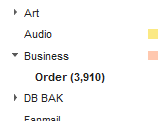
Grid Sage Games Inbox Order Counter
The all-important Order counter :P
Throughout Year 2 I made a more concerted effort to ensure there was always something to show at least once every week, and I believe this is reflected in the relative number of zero days: Year 1 was 9.8% (36) zero days, compared to 4.9% (18) in Year 2. In fact, the improvement is technically even better than that: notice a third of Year 2's zero days occurred close together over summer 2016--that was during my one-month vacation. No work, no pay xD

Cogmind Year 2 Revenue Zero Days
Cogmind Year 2 revenue zero days.Looking at revenue on a monthly basis, there's been a clear positive trend over the past year. (May passed $3k with its Beta release, though isn't shown here as it technically extends into the third year.)
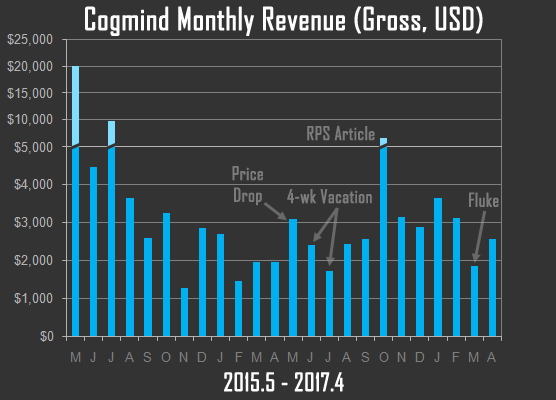
Cogmind Monthly Revenue (Gross), 2015.5 - 2017.4
Cogmind monthly gross revenue, annotated.
I've labeled a few of the larger effects already discussed earlier, though I can find no reasonable explanation for March. The graph includes Year 1 for comparison, though I didn't annotate those months--that stuff was covered with the first year's data.
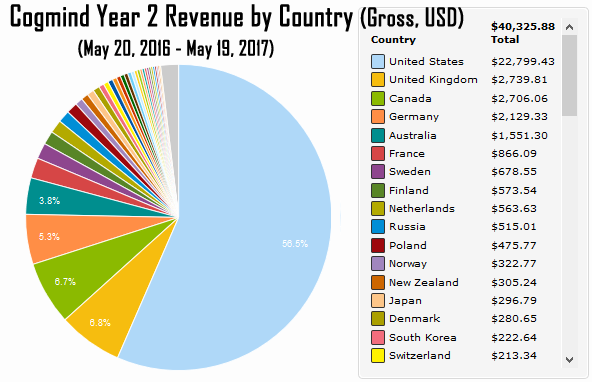
Cogmind Year 2 Monthly Revenue (Gross), by Country
Cogmind Year 2 monthly gross revenue by country.
By country the revenue data doesn't hold many surprises. Comparing to Year 1's country revenue graph, the only notable difference is that Germany overtook Australia, somewhat interesting because as an English-only game Cogmind is assumed to mostly sell in native English countries. Of course, Germany does have plenty of English speakers as well as three times the population of Australia, and (perhaps more key here) more than one German LP'er picked up Cogmind over the past year. (Plus there was the mentioned VAT change in November!)
That graph would be far more interesting if there were localization, but at least this gives you an idea of what an English-only fairly text-heavy game can achieve in an international sense. Localization is a great idea for any game that can manage it, but sadly it's simply not possible with Cogmind.
Pricing
But we do have some extra interesting data to analyze for Cogmind's second year of sales, now that we've been through multiple tier and pricing adjustments!
At the beginning of the year I wrote a lot about Cogmind's first price change in 2016, including some common and not-so-common variables factored into my pricing decisions. Here I'll add to that discussion with some final results of that change and the most recent third phase.
As a reminder, Cogmind's base price was $30 for the first 12 months, $24.99 for the 11 months following that, then $19.88 for the last month of the second year (and on through today). In the context of daily revenue above I already talked about some of the more immediate effects of those price changes, but the bigger picture holds a few more details. One element I finally have enough data to explore is Cogmind's conversion rate.
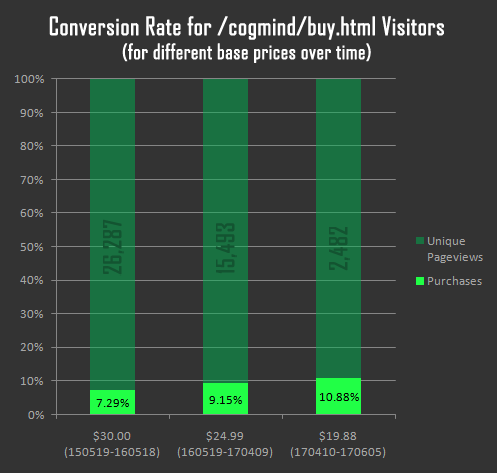
Cogmind Lifetime Conversion Rate (2015.5-2017.5) Based on buy.html Visitors
Cogmind lifetime conversion rate (2015.5 ~ 2017.5) based on buy.html visitors.
I wouldn't read too much into that graph because there are a lot of factors at play here, so many that this data is not quite as meaningful as it appears, but it's fun so I wanted to talk about it anyway :P
First of all, notice that it's specifically the buy page! Unlike most other indie developers, I don't put a buy link on Cogmind's main web page. In fact, I also don't even put it front and center at the top of the buy page itself! I prefer to 1) avoid generating impulse buys and 2) manage potential player expectations. Thus I intentionally force visitors to wade through other stuff before finding a link to actually buy the game :). Yes, it's counterproductive from a marketing standpoint, but I don't care, I'm here to build a good game and foster a healthy community, not rake dollars from random people on the internet.
Thus this source data definitely skews the conversion rate higher, because anyone arriving on that page already has a somewhat higher interest in purchasing than the average visitor. (Note that based on general industry data, those rates are high.) For comparison I did the same with /cogmind/index.html.
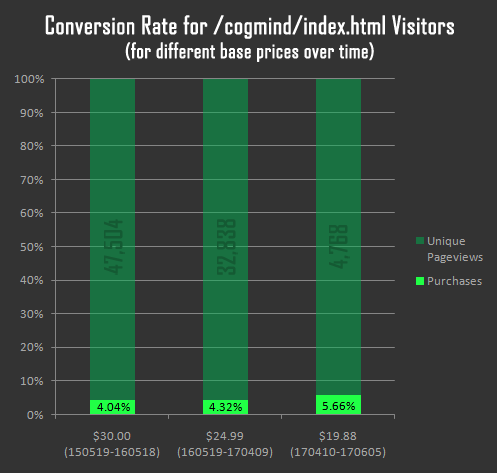
Cogmind Lifetime Conversion Rate (2015.5-2017.5) Based on index.html Visitors
Cogmind lifetime conversion rate (2015.5 ~ 2017.5) based on index.html visitors.
Part of the problem with sourcing stats from main page hits is that they're filled with referral spam which can't always be completely distinguished from real visits (which, like incessant referral spam, may simply leave without visiting other pages :P). This is why using the buy page provides nicer metrics, because it doesn't get referral spam--we just have to remember all the additional factors that feed into the buy.html stats.
Getting back to those factors, Cogmind's exposure comes primarily via roguelike-focused channels, so new visitors coming to the buy page are already going to be of a rogueliking disposition and even more likely to buy :)
Also specific to the fact that I prefer basing data on the buy page, there are a lot of people who have followed development for a long time, even years, who eventually make the decision to buy when it's right for them, whether due to a lower price,the right timing, or a combination of other personal factors. I believe there's a fairly steady stream of people who fall under this category, and they'll naturally just go to the buy page and... buy. This is often after having mostly obtained information about the game through one of the other channels I frequently use, like Twitter, r/Cogmind

































